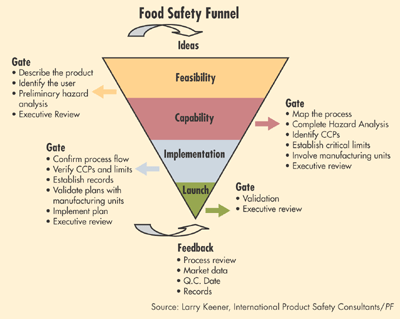
The production and distribution of wholesome and safe foods, long primarily the concern of food safety professionals, are gaining greater appreciation among not only non-technical people within the industry, but by the general public as well. This partly is evidenced by the rapid increase in retail markets offering irradiated ground beef products, a response to high-profile cases of foodborne pathogens. Some consumers feel that the microbial safety benefits imparted by the irradiation process outweigh any concerns about the process itself.
This greater appreciation of food safety also has resulted in changes in the product development process. Many food companies now address food safety issues at each step in the development process, that is, from the idea phase to commercial manufacturing of the final product. According to Larry Keener, general manager of International Product Safety Consultants (Seattle) who also developed the Food Safety Funnel (see illustration on page 60), “There is a growing awareness among marketing people on the importance of food science.”
The Food Safety Funnel provides a blueprint for incorporating food safety into each step of the product development process. As always, the most important point is commitment from management. Some have suggested an additional step—management support—be added at the very beginning of the 12-step flow diagram for Hazard Analysis and Critical Control Points (HACCP) development. HACCP is the food safety program supported by both the National Advisory Committee for Microbiological Criteria for Foods (Washington) and the Codex Food Hygiene guidelines.
Management can play a key role in fostering an environment where the individual groups responsible for bringing products to market work together for the common good of the company. Too often, marketing, sales, R&D, production, customer services and even those responsible for food safety end up in an endless turf battle to the detriment of all.

Begin at the Beginning
The first step in the development process is the development of ideas for new or improved products. Traditionally the role of marketing, this should be a group effort. R&D can provide input on feasibility and possible barriers to development. The group responsible for food safety, whether part of quality assurance or a separate entity, should provide input on potential hazards and safety concerns at this early “Feasibility” point.For example, if the marketing group for an ice cream manufacturer proposes the company develop a new Rocky Road product that incorporates Brazil nuts, the food safety group needs to provide a preliminary hazard analysis to marketing and others responsible for giving a go-ahead for project. Their comments might be something like this:
“We currently are not using Brazil nuts in any of our products. In fact, we use no nuts at all at this time. Nuts are a known allergen, and introducing them into our products and processing plants will create a potential allergen hazard. The addition of this product to our product line will entail the adoption of new production protocols to assure all of our products are protected. This will, of course, increase costs.”
Before making a final decision on using nuts, an analysis may be conducted on the amount of time and money required to develop and implement allergen control programs in the company's plants. Such an analysis should include—but need not be limited to—worker education needs, changes in cleaning procedures, changes in production schedules to minimize the potential of contamination, and development or alteration and implementation of HACCP plans.
Concern over the possible contamination of other products with potential allergens has resulted in many operations initiating programs to reprint labels…another cost. Even though the Food and Drug Administration does not necessarily support the practice, processors concerned about contamination with allergenic materials often use the statement “May contain Brazil nuts” (or whatever allergen about which they are concerned) on their label. They are protecting themselves and the consumer.
Helpful Hurdles
Once the decision is made to move forward with the new product, the food safety team should be included in new product development effort. They have the responsibility of following-up on the results of the earlier preliminary hazard analysis.The hazards and the programs to address those hazards depend upon the product. The food safety team must understand the nature of the hazards, regulatory issues and the company's production capabilities when designing these programs. Since the most difficult challenge often is developing products that meet marketing's preliminary concept, food safety should be involved from day one. For example, if the goal is to produce a fresh salsa, the development team has much greater flexibility if marketing does not specify that the product is “all natural,” which may eliminate the use of a microbial control ingredient such as sodium benzoate.
Although biological hazards usually are the primary focus of food safety plans, HACCP addresses physical and chemical hazards—including allergens—as well.
During the development process, building safety into the product may be achieved through a combination of product formulation and the process. The desired option is to remove the potential for any biological hazards, particularly pathogens for which there is “zero tolerance” such as Salmonella, Listeria or E. coli 0157:H7. Heat is often the best way to eliminate food pathogens, thus fresher, minimally processed products magnify challenges for the food safety professional. With such products, hurdle technology, which utilizes different elements or hurdles, such as pH, acid, antimicrobials, salt, packaging or others, are used in combination to control or eliminate the hazard. Each element by itself would not be adequate.
A sound tactic is to define the goals, methods to meet those goals (experimental design) and the means for evaluating success before work commences. When formulating a product with ingredients that constitute a hurdle, several approaches can test the adequacy. If the new product is a line extension or a modification of an existing product, pre-existing baseline data may be enough to judge the formula's safety. Ideally, researchers should seek to learn the effects on each “hurdle” component individually. The different elements then can be combined to determine synergistic effects. Hopefully one reinforces the other so that, in combination, the benefits of the individual materials are higher.
The programs to assure safety must be realistic and cost effective. For example, popular in markets today are cooked, vacuum packaged entrées sold in refrigerated deli cases. Such items as meat loaf with gravy, beef stew and others, if packed in cans, would be regulated as low-acid canned foods. Would a challenge study using Clostridium botulinum be a good idea? Very likely, the organism would grow, but would such spending the money to demonstrate that be worthwhile? Would the study be cost effective?
Reality Check
When the product goes from the “bench” to the plant for test runs or test market, the food safety team should go with the product and implement the rest (steps 3 through 12) of the HACCP plan. It must be made to work in the “real world.” Part of the implementation process may include educating plant staff on basic food safety principles and specifically, what needs to be done to assure the safety of the new product or products. Of course, the food safety group should build in one or more mechanisms for feedback on the system's performance. Accepting the status quo and not encouraging change is a formula for trouble. A well thought-out and executed plan goes a long way to protect a product, and a company.Website Resources
www.fsis.usda.gov— USDA's Food Safety And Inspection Service searchable website with topics ranging frombiosecurity to HACCP
http://vm.cfsan.fda.gov/~lrd/haccp.html— FDA's educational website on HACCP with particular focus on juice and seafood
www.foodsafety.gov— Gateway to government information on food safety
www.hi-tm.com— Consulting firm's website on HACCP for foodservice
Sidebar: Safety During Distribution
The safety of the U.S.'s food supply has been in question especially after the September 11, 2001 terrorist attacks. Luckily, canned, bottled and other packaged foods would show evidence of being tampered and are not easy targets for terrorist attacks. However, trucks that carry bulk items such as produce are vulnerable if basic safety procedures are not followed.While being very careful not to reveal information that could be used maliciously, Norm Singer, president, Ideas Workshop (Northbrook, Ill.), a firm that provides technical creative services to the food and nutraceutical industries, suggests that distributors be very careful about who accesses their trucks. “There needs to be a professional, objective assessment of the premises and their practices. Some of these people have lived with their businesses for such a long time that they no longer can see points of vulnerability, such as when trucks are left open and unguarded,” Singer says.
Presently, security seals—stamped metal or plastic tags that self-destruct if someone tries to tamper with them—are used to protect high-value items such as sides of beef. The seal is put on the door after the truck is loaded and its cargo inspected. The person receiving the shipment checks the seal to make sure it is still intact. For increased safety, these types of seals could also be used on trucks delivering bulk foods.
“Most processors don't think they have something to steal—they don't think of a case of lettuce as especially valuable. But, if they think in terms of bio-terrorism, their thinking would be different. While a terrorist attack on our food supply would not be the 'fault' of the trucking company, it would be safer from implication if it could prove it had done everything reasonable to defend itself.”
—Julia M. Gallo-Torres, Senior Editor